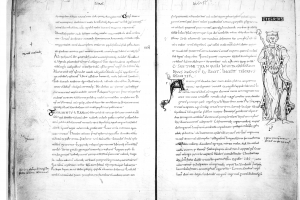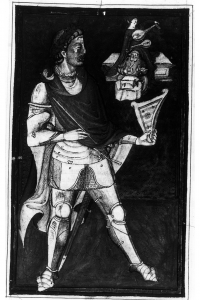
Thanks to the Duke Classics Department, this summer I was able to complete some research necessary for my senior honors thesis at the Vatican Film Library at Saint Louis University. My senior honors thesis is centered on a copy of an English translation of Suetonius’ De vita caesarum in the Rubenstein Rare Book & Manuscript Library here at Duke. This translation is a limited edition (only 300 copies printed) from 1930 and features a dozen illustrations by Frank Papé, a British artist who had some renown at the time. The illustrations are uniquely intriguing, portraying the emperors and their sordid crimes in a cartoonish, even goofy manner that seems to clash with Suetonius’ oftentimes graphic descriptions of their violence, lust, and greed. I wanted to be able to contextualize these illustrations within the larger tradition of this text, and a quick preliminary search revealed that the Vatican Library possesses a collection of Suetonius manuscripts, over a dozen of which bear some form of illustration. I was excited to learn that Saint Louis University has microfilm copies of these manuscripts in their Vatican Film Library, because Missouri seemed much more accessible than Rome.

I flew to St. Louis during Undergraduate Reading Period, able to sneak out and back in between LDOC and my first final exam. I spent two full days in the Library, learned how to use a microfilm reader, and viewed a dozen medieval and early modern manuscripts that are directly relevant to my research. Some of these manuscripts had only limited decoration, with illuminated capitals at the beginning of chapters or floral embellishments on the cover page. But a few had full-length portraits of Suetonius’ characters: one shows Julius Caesar crowned and holding a palm frond; another Tiberius wearing a cloak and scepter; a third features a full-page illustration of Nero playing an instrument and wearing a suit of armor that I would think would have been more likely worn by King Arthur than Nero. Another manuscript twice had illustrations of tiny men within the capital letters beginning new chapters, and although both figures are unidentified, they still add to the tradition of portraits and illustrations within Suetonius’ De vita caesarum.

My research at the Vatican Film Library continues to inform my process as I am moving along with my investigation of the 1930 edition of the same text at the Rubenstein Library under the guidance of my advisor, Professor Boatwright. In comparison to the stately portraits from these early manuscripts, Papé’s illustrations in this twentieth century translation seem outright bizarre, more of a cartoon or caricature than a mere interpretation of the text. I am grateful to have this context to which I can compare the 1930 illustrations, and am excited to see how the rest of my thesis unfolds as I continue to research both the early manuscripts and this newer edition.